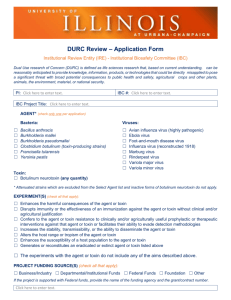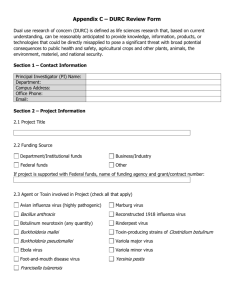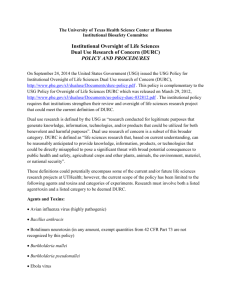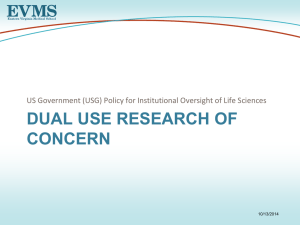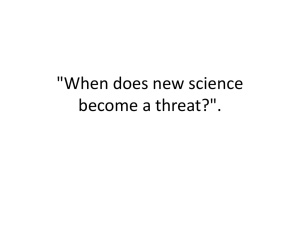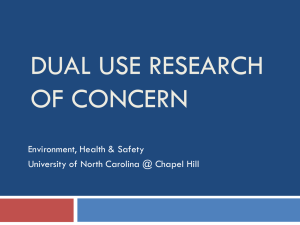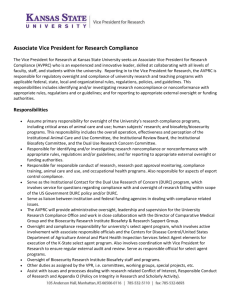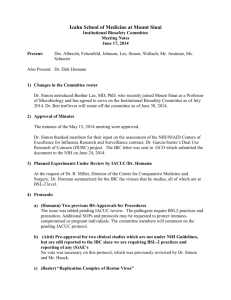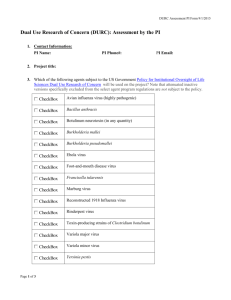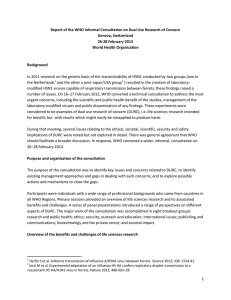TRAINING ON THE US GOVERNMENT POLICY FOR INSTITUTIONAL USE RESEARCH OF CONCERN
advertisement
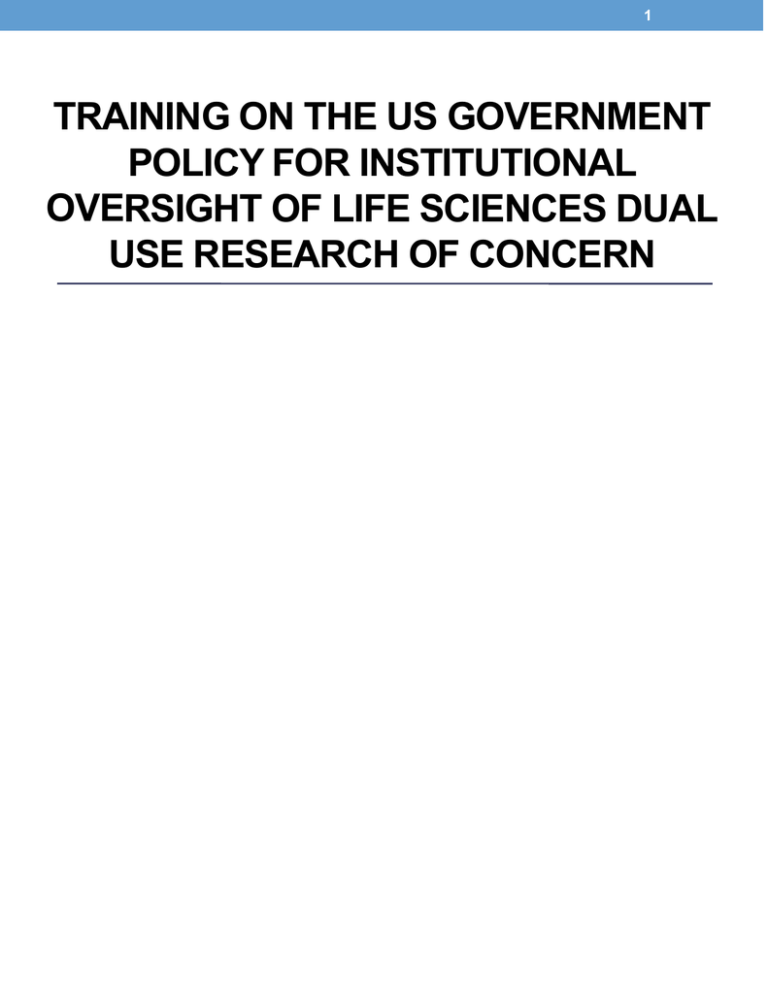
1 TRAINING ON THE US GOVERNMENT POLICY FOR INSTITUTIONAL OVERSIGHT OF LIFE SCIENCES DUAL USE RESEARCH OF CONCERN 2 Purpose This presentation provides an overview of the US Government Policy for Institutional Oversight of Life Sciences Dual Use Research of Concern (DURC) The slides may be used to: promote understanding of the issues associated with dual use research in the life sciences highlight the importance of the need for responsible conduct and oversight of such research, and educate on the specific requirements of individuals and entities under the Policy 3 Overview of Training What is Dual Use Research in the Life Sciences? Oversight of Dual Use Research of Concern Key Responsibilities of Institutions, Investigators, the U.S. Government, and Others under the Institutional DURC Oversight Policy Resources, including the “Companion Guide” 4 DUAL USE RESEARCH IN THE LIFE SCIENCES 5 Importance of Life Sciences Research Life sciences research underpins: Biomedical and public health advances Improvements in agriculture Safety and quality of food supply Environmental quality Strong national security and economy 6 Dual Use Research In The Life Sciences Good science can be put to bad uses Dual use research (DUR) is research conducted for legitimate purposes that generates knowledge, information, technologies, and/or products that can be utilized both for benevolent and harmful purposes 7 Dual Use Research of Concern (DURC) Most life sciences research conceivably could be considered DUR in that it has some potential to generate information that could be misused There is a subset of research that has the greatest potential for generating information that could be readily misused in ways that threaten public health and national security. Such research has been termed (DURC) and is the focus of the US Government oversight policies 8 US Government Definition of DURC 9 OVERSIGHT OF DUAL USE RESEARCH OF CONCERN 10 Oversight of DURC The dual use potential of certain life sciences research has been recognized as an important biosecurity issue for a number of years Managing the risks associated with DURC is a responsibility shared by: Researchers Journal editors and publishers Institutional officials Local oversight bodies The Federal government 11 US Government Policies for DURC Oversight There are two US Government policies that address the oversight of life sciences DURC. The United States Government Policy for Oversight of Life Sciences Dual Use Research of Concern (March 2012) The United States Government Policy for Institutional Oversight of Life Sciences Dual Use Research Of Concern (September 2014) Available at www.phe.gov/s3/dualuse 12 US Government Policies for DURC Oversight These policies: Aim to preserve the benefits of life sciences research while minimizing the risk of misuse of the knowledge, information, products, or technologies provided by such research; and Complement existing regulations and policies governing the safe and secure use of pathogens and toxins Whereas the March 2012 policy describes the responsibilities of Federal agencies, the September 2014 policy primarily describes the responsibilities of institutions 13 Research Subject to the Policies Does research involve one or more of 15 agents or toxins listed in the Policy? Does research aim to produce one of seven listed experimental effects? Does research meet definition of DURC? nal Federal ght and risk tegies to e concerns 14 The US Government Policy for Oversight of Life Sciences DURC (March 2012) Requires Federal departments and agencies to review their research portfolios, both intramural and extramural, to: Identify all research under the policy with DURC potential Mitigate the risks posed by any DURC identified 15 The USG Policy for Institutional DURC Oversight (September 2014) Institutional oversight of DURC is a critical component of a comprehensive oversight system that involves: Principal Investigators (PIs) Institutional Review Entity (IRE) Institutional Contact for Dual Use Research (ICDUR) Institution United States Government (USG) 16 Overview of the Process for Institutional DURC Oversight 17 Entities Subject to the Institutional DURC Oversight Policy Federal departments and agencies that fund or conduct life sciences research Institutions within the United States that: Receive Federal funds to conduct or sponsor life sciences research; and Conduct or sponsor research that is subject to the Policy, regardless of source of funding Institutions outside of the United States that receive Federal funds to conduct or sponsor research subject to the Policy 18 What Research is Subject to the Policy? Research that uses one or more of the agents or toxins listed in the Policy to discern if it: Produces, aims to produce, or can be reasonably anticipated to produce one or more of the seven listed experimental effects 19 What Research is Subject to the Policy? Research that directly involves any of the following 15 agents and toxins* Avian influenza virus (highly pathogenic) Bacillus anthracis Botulinum neurotoxin (in any quantity) Burkholderia mallei Burkholderia pseudomallei Ebola virus Foot-and-mouth disease virus Francisella tularensis Marburg virus Reconstructed 1918 Influenza virus Rinderpest virus Toxin-producing strains of Clostridium botulinum Variola major virus Variola minor virus Yersinia pestis * Except attenuated strains of the agents that are excluded from the Select Agent list and inactive forms of botulinum neurotoxin 20 What Research is Subject to the Policy? Experimental effects Enhances the harmful consequences of the agent or toxin Disrupts immunity or the effectiveness of an immunization against the agent or toxin without clinical and/or agricultural justification Confers to the agent or toxin resistance to clinically and/or agriculturally useful prophylactic or therapeutic interventions against that agent or toxin or facilitates their ability to evade detection methodologies Increases the stability, transmissibility, or the ability to disseminate the agent or toxin Alters the host range or tropism of the agent or toxin Enhances the susceptibility of a host population to the agent or toxin Generates or reconstitutes an eradicated or extinct agent or toxin listed in the policy 21 Determine if the Research Meets the Definition of DURC If the research with any of the 15 agents involves any of the 7 experimental effects, conduct a risk assessment to determine if it meets the following definition: 22 Risk Assessment and Risk Mitigation For projects that are determined to meet the definition of DURC, the IRE must develop a risk mitigation plan to apply any necessary and appropriate risk mitigation measures 23 Management of DURC-Associated Risks DURC risk mitigation strategies may include: Changing the design or conduct of the research or not conducting certain aspects of DURC Applying specific biosecurity and/or biosafety measures Developing a plan for monitoring the research for findings with additional DURC potential Developing plan for responsibly communicating the results of DURC In instances, when appropriate, restricting communication of experimental details or other specific information 24 KEY RESPONSIBILITIES OF INSTITUTIONS 25 Key Responsibilities of Institutions Establish and implement policies and practices for identification and oversight of DURC that include: Establishing an IRE Ensuring appropriate review of research with DURC potential Assessing the potential risks and benefits associated with DURC Developing and implementing risk mitigation plans, as necessary 26 Key Responsibilities of Institutions … continued Ensuring compliance with the Policy and approved risk mitigation plans Ensuring periodic review and updating of risk mitigation plans Providing education and training on DURC Assisting investigators when questions arise regarding research that may be subject to the Policy 27 Key Responsibilities of Institutions Notify USG funding agencies of: Research reviewed by the IRE that involves one of the seven experimental effects, including whether the research is determined to be DURC Instances of noncompliance with the Policy Proposed risk mitigation plans for research determined to be DURC Changes in status of DURC or modification to risk mitigation plans 28 KEY RESPONSIBILITIES OF INVESTIGATORS 29 Key Responsibilities of Investigators Identify and refer to the IRE all research involving one or more of the agents or toxins listed in the Policy, along with an assessment of whether the research involves any of the seven listed experimental effects Work with the IRE to assess the dual use risks and benefits of the research in question and develop risk mitigation measures 30 Key Responsibilities of Investigators Conduct DURC in accordance with the risk mitigation plan Be knowledgeable about and comply with all institutional and Federal policies and requirements for oversight of DURC Continue to assess research to determine if, at any time, the research becomes subject to the policy 31 Key Responsibilities of Investigators Ensure that laboratory personnel (e.g. graduate students, postdoctoral fellows, research technicians, laboratory staff, and visiting scientists) conducting research with any of the 15 listed agents have received education and training on DURC Communicate DURC in a responsible manner, throughout the research process, not only at the point of publication Ensure that communication is in compliance with the risk mitigation plan approved by the appropriate Federal funding agency 32 KEY RESPONSIBILITIES OF THE INSTITUTIONAL REVIEW ENTITY (IRE) 33 Key Responsibilities of the IRE Be composed of at least 5 members, including persons with knowledge of US government policies and sufficient range of expertise to assess the dual use potential of research conducted at that institution Review of research identified by PIs: 1. 2. 3. Verification that the research involves one or more of the 15 listed agents Review of the PIs assessment and final determination of whether the research meets any of the seven experimental effects When appropriate, make a determination of whether the research meets the definition of DURC 34 Key Responsibilities of the IRE For research determined to be DURC, the IRE: Consider the risks and benefits of conducting the research Works with the appropriate Federal funding agency to develop a risk mitigation plan Reviews the risk mitigation plan at least annually and modifies the plan, as warranted 35 KEY RESPONSIBILITIES OF THE INSTITUTIONAL CONTACT FOR DUAL USE RESEARCH (ICDUR) 36 Key Responsibilities of the ICDUR Serve as institutional point of contact for questions regarding compliance with and implementation of the requirements for the DURC oversight policies Serve as liaison between the institution and the relevant USG funding agency Consult with the relevant USG funding agency when the institution seeks advice on matters related to DURC 37 KEY RESPONSIBILITIES OF US GOVERNMENT FUNDING AGENCIES 38 Key Responsibilities of US Government Funding Agencies Require policy implementation at all institutions subject to the Policy. When notified by an institution of research meeting the scope of the Policy: Notify the institution when the USG funding agency disagrees with any part of the IRE’s review outcome For research determined to be DURC, work with the institution to finalize a risk mitigation plan Respond to questions from institutions regarding DURC oversight and compliance with the Policy Respond to reports of non-compliance and work with the institution to address such non-compliance 39 KEY RESPONSIBILITIES OF THE US GOVERNMENT 40 Key Responsibilities of the US Government Provide guidance to institutions regarding review, management, and responsible communication of DURC Develop training tools and materials for use by the USG agencies and institutions implementing the Policy Provide education and outreach to stakeholders about dual use policies and issues Assess periodically the impact of the Policy on life sciences research programs and, as appropriate, update the Federal and institutional dual use research oversight policies 41 RESOURCES 42 Resources Companion Guide A compendium of tools to assist investigators and research institutions in the implementation of DURC oversight Case Studies Provide a range of examples of research that is subject to the policy and demonstrate the type of analysis that should be brought to bear during institutional reviews These tools promote the: understanding and identification of DURC risk assessment and development of risk mitigation plans and risk management processes responsible communication of DURC, and training and education on DURC 43 Companion Guide Available at: www.phe.gov/s3/dualuse 44 Companion Guide The Companion Guide includes: Frequently asked questions regarding US Government DURC oversight policies Guidance for PIs on identification and assessment of research that requires institutional review Guidance for IREs on conducting institutional review, including risk assessments and drafting and review of risk mitigation plans Guidance to all audiences on responsible communication of DURC Templates (optional) for institutions to use in fulfilling policy requirements 45 Case Studies Insert image of front page of case studies Available at www.phe.gov/s3/dualuse 46 Available on YouTube: http://www.youtube.com/watch?v=0yS1ur24j40 47 Investigator Brochures To request copies email: PBBP@od.nih.gov 48 Poster To request copies email: PBBP@od.nih.gov 49 Additional Information Information about dual use research in the life sciences as well as specific details on the United States Government Policy for Institutional Oversight of Life Sciences Dual Use Research of Concern can be found at: www.phe.gov/s3/dualuse 50 Implementation Questions Questions about implementing the Policy may be sent to: DURC@ostp.gov
